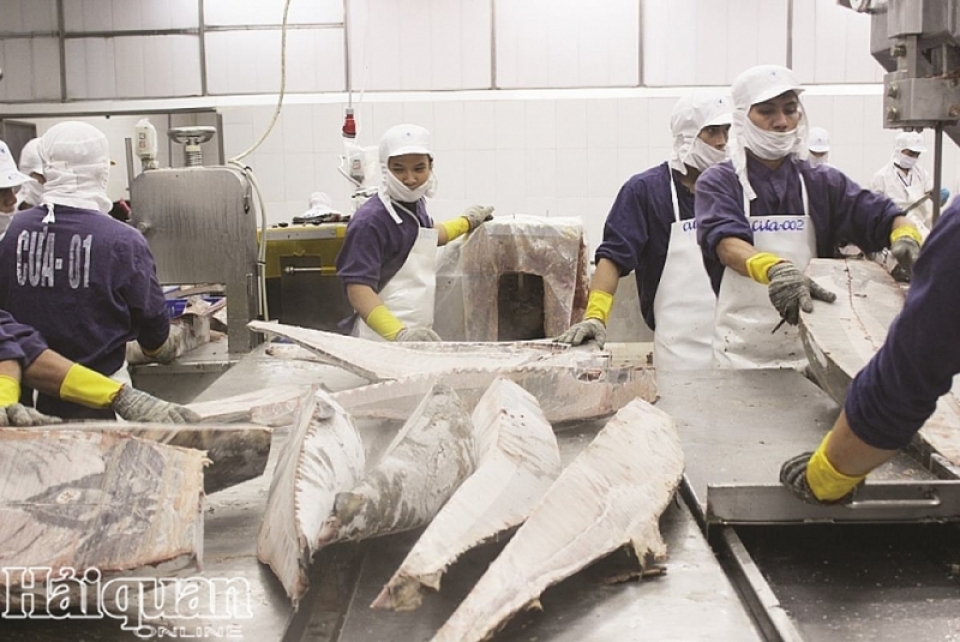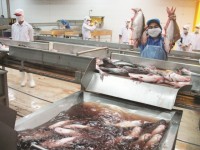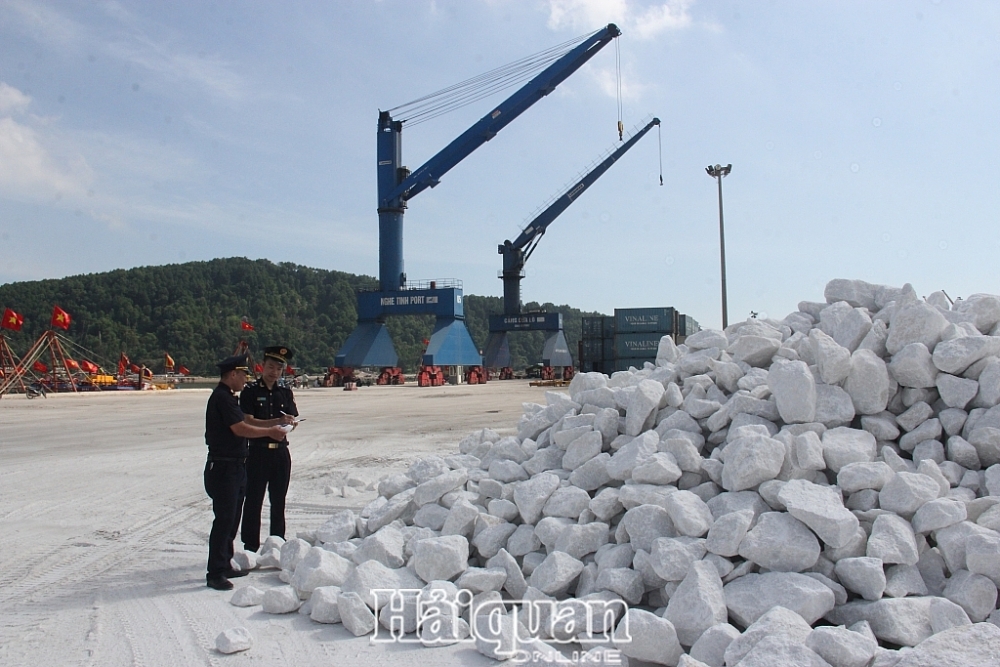Fisheries industry focusing on solutions to comply with EU regulations
| Food industry holds great potential for investment attraction | |
| Fisheries enterprises propose to keep current working hours | |
| Fisheries sector required to continue improving product quality |
 |
| Seafood processing enterprises must pay attention to input materials. Photo: T.H. |
On January 9, at a conference to discuss solutions to manage the use of Ethoxyquin according to EU regulations, organised by the Directorate of Fisheries, both animal feed processing enterprises and fisheries export enterprises expressed concern.
According to Tran Dinh Luan, Director General of the Directorate of Fisheries, in 2017, the EU issued Decision 2017/962 on controlling Ethoxyquin, with a transition period until the end of March 31, 2020. After this date, the EU bans "Ethoxyquin for food and feed ingredients for all animals, including fisheries." This EU regulation directly bans Ethoxyquin in feed for animal and fisheries and is different from the Japan-Korea-US regulation that controls (with maximum residue levels MRL) ethoxyquin residue in finished products of imported shrimp.
General Secretary of Vietnam Association of Seafood Exporters and Producers (VASEP) Truong Dinh Hoe said to have good preparation and stabilise shrimp exports to the EU, especially time closer to the effective date of Decision 2017/962 (31 / 3/2020), VASEP organised a meeting of fisheries enterprises (shrimp and fish) to inform firms of the EU regulation, update Ethoxyquin control situation at fisheries factories, as well as inadequacies of enterprises in Ethoxyquin control in export products.
Recently, enterprises have worked to conduct sampling of raw shrimp to evaluate Ethoxyquin. In total, there were 152 samples of raw shrimp and after evaluation, 83 samples did not meet Ethoxyquin level, accounting for nearly 55 percent.
Currently, there are big feed companies in the market such as CP, Thang Long, Grobest, Uni President and Tong Wei, accounting for more than 70 percent of the aquatic animal feed market. The inspection of shrimp sources using feeds of these companies showed almost all raw shrimp using CP feed did not contain Ehthoxyquin residue, while all others contained Ethoxyquin residue.
As a leading shrimp exporter, the representative of Minh Phu Hau Giang Company said that not only the EU market, but also other markets make requests on Ethoxyquin residue in the feed production. Animal feed supply companies only sell in the domestic market and do not export to Europe, consequently they cannot commit Ehthoxyquin residue in feed, that imposes pressure on enterprises in using processing materials.
According to Truong Dinh Hoe, concerns about Ethoxyquin are just speculation that have not been proven and recognised. However, many markets have relied on this speculation, so Ethoxyquin is still used as an effective trade barrier.
This was proved when fisheries exports to the EU in 2019 decreased by more than 16 percent, of which shrimp exports fell by more than 18 percent compared 2018.
According to regulations of the Ministry of Agriculture and Rural Development, Ehtoxyquin is not banned in production of aquatic feed and the current acceptable level is relatively higher than in other import markets for aquatic products. This creates a contradiction in regulations on using Ethoxyquin and Ethoxyquin residue levels in fishery products, so it is tough for companies to control Ethoxyquin residues to market regulations.
To support businesses and production and supply chains of shrimp can control Ethoxyquin residue in export products to foreign markets especially the EU, VASEP and fisheries enterprises shall propose the Ministry of Agriculture and Rural Development make a written request for food processing factories to clearly announce Ethoxyquin content on product packaging.
At the same time, they should put Ethoxyquin indicator and Ethoxyquin labeling into the list of periodic and additional inspections (post-audit) of the Directorate of Fisheries. They should also consider and consult EU authorities on stipulating the acceptable Ethoxyquin residue level in aquatic products such as Japan, South Korea and USA.
 | Fisheries with the goal of exporting 10 billion USD VCN- On the export growth trend of more than 8% in 2018 with the export turnover of ... |
From the perspective of animal feed production companies for aquaculture, the firms said that domestic animal feed production companies did not add Ethoxyquin in production, but Ethoxyquin originated from raw materials. A representative of Unipresidend said the feed originated from main raw materials as fish powder for anti-oxidation during transportation, but their feed production factory did not add this substance to the product. The company contacted foreign suppliers and were told exports of raw materials to Vietnam were not significant, so it is difficult for them to adjust raw material production. The company is still looking for solutions.
| Ethoxyquin is a quinoline-based antioxidant used as a food preservative in some countries and initially to control burns on pears after harvest. In Vietnam, Ethoxyquin is not banned in the production of animal and aquatic feeds with an acceptable level in aquatic feed of 150mg / kg (150ppm). |
Related News

Complying with regulations of each market for smooth fruit and vegetable exports
13:06 | 09/01/2025 Import-Export

Increasing consumption demand, steel enterprises have many opportunities
07:43 | 31/12/2024 Import-Export

The Middle East: a promising seafood export market for Vietnam
07:43 | 31/12/2024 Import-Export

Export tax rates of 13 commodity codes to increase to 20% from January 1, 2025
13:46 | 28/12/2024 Regulations
Latest News

Fruit and vegetable industry aims for $10 billion in exports by 2030
15:12 | 07/01/2025 Import-Export

GDP grows by over 7 per cent, exceeds target for 2024
15:11 | 07/01/2025 Import-Export

Vietnamese pepper: decline in volume, surge in value
15:10 | 07/01/2025 Import-Export

Việt Nam maintains position as RoK’s third largest trading partner
15:09 | 07/01/2025 Import-Export
More News

Greater efforts to be made for stronger cooperation with European-American market
15:08 | 06/01/2025 Import-Export

Leather, footwear industry aims to gain export growth of 10% in 2025
15:06 | 06/01/2025 Import-Export

Grasping the green transformation trend - A survival opportunity for Vietnamese Enterprises
14:53 | 06/01/2025 Import-Export

Việt Nam to complete database of five domestic manufacturing industries in 2026
20:57 | 05/01/2025 Import-Export

Logistics firms optimistic about growth prospects in 2025: Survey
20:54 | 05/01/2025 Import-Export

Vietnamese products gain popularity in the UK, EU
14:39 | 03/01/2025 Import-Export

Việt Nam set to become regional manufacturing tech hub this year
15:53 | 02/01/2025 Import-Export

Computers, electronics and components lead imports in 2024
15:51 | 02/01/2025 Import-Export

Hardware and electronics exports rebound
13:31 | 01/01/2025 Import-Export
Your care

Complying with regulations of each market for smooth fruit and vegetable exports
13:06 | 09/01/2025 Import-Export

Fruit and vegetable industry aims for $10 billion in exports by 2030
15:12 | 07/01/2025 Import-Export

GDP grows by over 7 per cent, exceeds target for 2024
15:11 | 07/01/2025 Import-Export

Vietnamese pepper: decline in volume, surge in value
15:10 | 07/01/2025 Import-Export

Việt Nam maintains position as RoK’s third largest trading partner
15:09 | 07/01/2025 Import-Export



